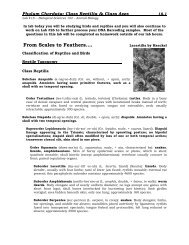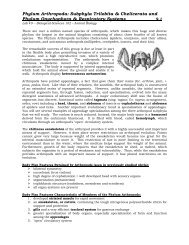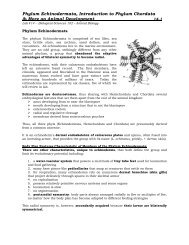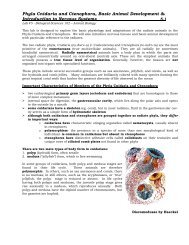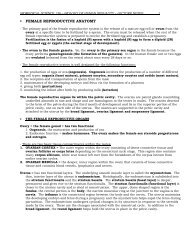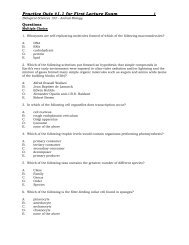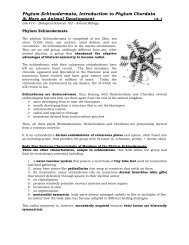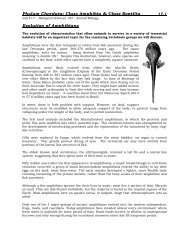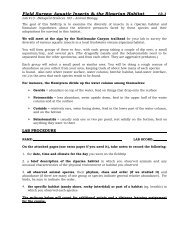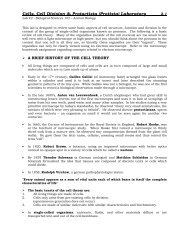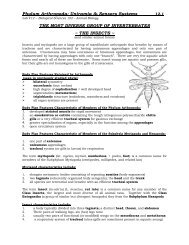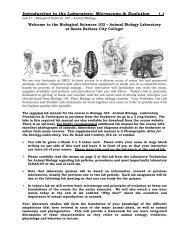Lab #6 - Phyla Platyhelminthes, Nemertea ... - Biosciweb.net
Lab #6 - Phyla Platyhelminthes, Nemertea ... - Biosciweb.net
Lab #6 - Phyla Platyhelminthes, Nemertea ... - Biosciweb.net
Create successful ePaper yourself
Turn your PDF publications into a flip-book with our unique Google optimized e-Paper software.
Acoelomates: Phylum <strong>Platyhelminthes</strong> and <strong>Nemertea</strong> and<br />
Pseudocoelomates: <strong>Phyla</strong> Nematoda and Rotifera & Parasitism 6.1<br />
<strong>Lab</strong> <strong>#6</strong> - Biological Sciences 102 – Animal Biology<br />
This lab is designed to explore the basic life history, physiology and adaptations of the acoelomate and<br />
pseudocoelomate animals with a focus on the <strong>Phyla</strong> Playthelminthes, <strong>Nemertea</strong> (Rhynchocoela),<br />
Nematoda, Rotifera. We will review the lifecycles of many of these species with an emphasis on<br />
their commonly parasitic nature. You must learn these lifecycles.<br />
Refer to chapters in the textbook for illustrations, diagrams, and<br />
additional information about acoelomates & pseudocoelomates.<br />
The Acoelomate Animals<br />
The acoelomates are animals that have no coelom (body cavity). They include flatworms, phylum<br />
<strong>Platyhelminthes</strong> (Gr. platys, flat, + helmins, worm); ribbon worms, phylum <strong>Nemertea</strong> (Gr. Nemertes,<br />
one of the Nereids, mermaids of Greek mythology); and jaw worms, phylum Gnathostomulida (Gr.<br />
gnathos, jaw, + stoma, mouth). In acoelomate animals, the space between the body wall (ectoderm)<br />
and digestive tract (endoderm) is not a cavity, as in coelomate animals, but is filled with muscle<br />
fibers and a loose tissue of mesenchymal origin, called parenchyma, both derived from mesoderm.<br />
The presence of a well-developed mesodermal layer makes the acoelomates triploblastic (having three<br />
germ layers: ectoderm, endoderm, and mesoderm). Flatworms are a large and economically important<br />
group because they include not only free-living planarians but also parasitic tapeworms and flukes.<br />
Acoelomates are more complex in organization than the radiate animals in several ways:<br />
‣ Acoelomates have bilateral symmetry<br />
‣ They have defined tissues organized into functional organs<br />
‣ They have a highly organized nervous system with concentration of nervous tissue and sense<br />
organs in the anterior end (cephalization)<br />
‣ They have an excretory system of specialized flame cells and tubules for elimination of<br />
nitrogenous wastes (breakdown products of protein, nucleic acid and other metabolism)<br />
‣ <strong>Platyhelminthes</strong> have a gastrovascular system, but ribbon worms have separated the two<br />
functions and have a complete mouth-to-anus digestive tract and a circulatory system<br />
‣ Flatworms have a tissue-organ level of organization<br />
Body Plan Features Retained by Acoelomates (seen in previously studied phyla):<br />
‣ true tissues present<br />
Body Plan Features & Characteristics of Members of the Phylum <strong>Platyhelminthes</strong><br />
(not seen in the Phylum Cnidaria – some of these traits are seen in other animal phyla in<br />
addition to the Phylum <strong>Platyhelminthes</strong>):<br />
1. acoelomate<br />
2. bilateral symmetry<br />
3. triploblastic structure (endoderm, mesoderm and ectoderm)<br />
4. some degree of cephalization = head with sensory organs<br />
5. more organ systems (simple and formed of true tissues) are present<br />
6. flame cells in flame bulbs for excretion<br />
7. gastrovascular cavity for digestion and gas exchange (organs near body surface)<br />
8. longitudinal, circular and ventro-dorsal muscles<br />
9. hydrostatic skeleton (as muscles push against parenchyma and tissue fluids)<br />
10. high surface-volume ratio as a result of flat shape (Important in locomotion and in exchange<br />
of nutrients and wastes).<br />
11. monoecious (hermaphroditic) = male and female organs in one individual<br />
12. most are parasitic, but some are free-living
Acoelomates: Phylum <strong>Platyhelminthes</strong> and <strong>Nemertea</strong> and<br />
Pseudocoelomates: <strong>Phyla</strong> Nematoda and Rotifera & Parasitism 6.2<br />
<strong>Lab</strong> <strong>#6</strong> - Biological Sciences 102 – Animal Biology<br />
Classification & Adaptations of Acoelomate Animals<br />
Phylum <strong>Platyhelminthes</strong> (flatworms)<br />
Class Turbellaria (tur'bel-lar' e-a) (L. turbellae, stir, bustle, + aria, like or connected with). About 3000<br />
species; Turbellarians. Mostly free-living, with a ciliated epidermis. A paraphyletic grouping. Example:<br />
Dugesia tigrina<br />
Class Monogenea (mon'o-gen'e-a) (Gr. mono, single, + gene, origin, birth). About 1100 species;<br />
Monoge<strong>net</strong>ic flukes. Adult body covered with syncytial tegument without cilia; leaflike to cylindrical in<br />
shape; posterior attachment organ with hooks, suckers, or clamps, usually in combination; all<br />
parasitic, mostly on skin or gills of fishes; single host; monoecious; usually free-swimming ciliated<br />
larva. Examples: Polystoma, Gyrodactylus<br />
Class Trematoda (trem'a-to'da) (Gr. trematodes, with holes, + eidos, form). About 10,000 species;<br />
Dige<strong>net</strong>ic flukes. Adult body covered with nonciliated syncytial tegument; leaf-like or cylindrical in<br />
shape; usually with oral and ventral suckers, no hooks; development indirect, first host a mollusc,<br />
final host usually a vertebrate; parasitic in all classes of vertebrates. Examples: Fasciola, Clonorchis,<br />
Schistosoma<br />
Class Cestoda (ses-to'da) (Gr. kestos, girdle, + eidos, form). About 3500 species; Tapeworms. Adult<br />
body covered with non-ciliated, syncytial tegument; scolex with suckers or hooks, sometimes both, for<br />
attachment; long, ribbonlike body, usually divided into series of proglottids; no digestive organs;<br />
parasitic in digestive tract of all classes of vertebrates; first host may be invertebrate or vertebrate.<br />
Examples: Taenia, Diphyllobothrium<br />
Phylum <strong>Nemertea</strong> or Rhynchocoela (ribbonworms)<br />
About 600 species. Ribbon worms are often called nemertine or nemertean worms. Nearly all are<br />
marine and are characterized by an eversible proboscis that can be thrown out with great speed to<br />
capture food. Ribbon worms have separated the two functions of the gastrovascular cavity in<br />
flatworms and have a complete mouth-to-anus digestive tract and a circulatory system. <strong>Nemertea</strong>ns<br />
occur in the intertidal, under stones or sea weed, or in burrows in muddy sand. <strong>Nemertea</strong>ns can be<br />
very long at up to 50 meters (these species are the worlds longest animals).<br />
Body Plan Features & Characteristics of Members of the Phylum <strong>Nemertea</strong><br />
(some of these traits are seen in other animal phyla in addition to the Phylum <strong>Nemertea</strong>):<br />
1. acoelomate, bilateral symmetry, triploblastic structure<br />
2. some degree of cephalization = head with sensory organs<br />
3. some organ systems (formed of true tissues) are present<br />
4. eversible proboscis (only worm phylum with this characteristic)<br />
5. complete digestive tract/system (from mouth-to-anus)<br />
6. separate circulatory system with two lateral vessels on each side of the gut and sinuses<br />
around head and tail; no definite closed circulation<br />
7. flame cells for excretion<br />
8. longitudinal and circular muscles contract against fibrous basement membrane; multiple<br />
patterns of muscle fiber organization<br />
9. hydrostatic skeleton (as muscles push against parenchyma and tissue fluids)<br />
10. dioecious with sexual reproduction or asexual fragmentation<br />
11. not parasitic, free-living
Acoelomates: Phylum <strong>Platyhelminthes</strong> and <strong>Nemertea</strong> and<br />
Pseudocoelomates: <strong>Phyla</strong> Nematoda and Rotifera & Parasitism 6.3<br />
<strong>Lab</strong> <strong>#6</strong> - Biological Sciences 102 – Animal Biology<br />
The Pseudocoelomate Animals<br />
All bilateral animal phyla except the acoelomates possess a body cavity belonging to one of two types:<br />
(1) true coelom, in which a peritoneum (an epithelium of mesodermal origin) covers both the<br />
inner surface of the body wall and the outer surface of the visceral organs in the cavity, or (2)<br />
pseudocoel, a body cavity not entirely lined with peritoneum (one layer of mesoderm attached to the<br />
ectoderm).<br />
A body cavity of either type is an advantage because it provides room for organ development and<br />
storage and allows some freedom of movement within the body. The cavity is often fluid-filled and<br />
provides for a hydrostatic skeleton in those forms lacking a true skeleton. There are nine<br />
pseudocoelomate phyla, of which phylum Nematoda is by far the largest. All pseudocoelomate phyla<br />
are at the organ-system level of organization.<br />
In general pseudocoelomates tend to be cylindrical in body form, to be unsegmented, and to have a<br />
complete (mouth-to-anus) digestive tract (this is absent in acanthocephalans). The epidermis is<br />
usually covered with a cuticle. There are both aquatic and terrestrial members, and parasitism is<br />
fairly common.<br />
Body Plan Features Retained by Pseudocoelomates (seen in previously studied phyla):<br />
1. presence of true tissues<br />
2. bilateral symmetry<br />
3. triploblastic structure (endoderm, mesoderm and ectoderm)<br />
4. some degree of cephalization = head with sensory organs<br />
5. some organ systems (formed of true tissues) are present<br />
Body Plan Features & Characteristics of Pseudocoelomates:<br />
1. possess a pseudocoelom (mesoderm lines ectoderm tissue side only)<br />
2. they are unsegmented<br />
3. complete digestive tract/system (from mouth-to-anus)<br />
4. epidermis is covered with a cuticle
Acoelomates: Phylum <strong>Platyhelminthes</strong> and <strong>Nemertea</strong> and<br />
Pseudocoelomates: <strong>Phyla</strong> Nematoda and Rotifera & Parasitism 6.4<br />
<strong>Lab</strong> <strong>#6</strong> - Biological Sciences 102 – Animal Biology<br />
Classification & Adaptations of Pseudocoelomate Animals<br />
Phylum Nematoda (roundworms)<br />
More than 25,000 species. Roundworms. Nematodes are an extensive group with worldwide distribution.<br />
They include terrestrial, freshwater, marine, and parasitic forms. They are elongated<br />
roundworms covered with a flexible, nonliving cuticle. Circular muscles are lacking in the body wall<br />
and, in Ascaris, longitudinal muscles are arranged in four groups separated by epidermal cords (some<br />
nematodes have six or eight groups of longitudinal muscles). Cilia are completely lacking. Nematodes<br />
are found free-living in almost every conceivable habitat from arid deserts to lake bottoms, rivers,<br />
polar seas. Nematodes - both parasitic and freeliving - are incredibly abundant. A handful of good<br />
garden soil contains thousands of nematodes. Some 50 different species of nematodes occur in<br />
humans, most of them nonpathogenic. Some nematodes are plant parasites feeding on plant sap,<br />
especially roots.<br />
Body Plan Features & Characteristics of Members of the Phylum Nematoda<br />
(some of these traits are seen in other animal phyla):<br />
1. pseudocoelomate<br />
2. bilateral symmetry<br />
3. triploblastic structure (endoderm, mesoderm and ectoderm)<br />
4. psuedocoelomate = possess a pseudocoelom<br />
5. some degree of cephalization = head with sensory organs<br />
6. some organ systems (formed of true tissues) are present<br />
7. vermiform (worm-like) body shape<br />
8. complete digestive tract with three angled (longitudinal, circular and oblique) muscular<br />
pharynx, intestine lacking muscular walls, short rectum and anus<br />
9. excretion and osmoregulation through the cuticle and by excretory canals<br />
10. lack both cilia and flame cells/bulbs<br />
11. body wall lined with cuticle which retains body shape<br />
12. longitudinal muscles only, no circular muscles in body wall; body length or diameter<br />
does not change in movement<br />
13. hydrostatic skeleton (as muscles push against parenchyma and tissue fluids)<br />
14. dioecious; sexes separate with females larger than males; one or two tubular gonads;<br />
copulatory spicules present in males<br />
Phylum Rotifera (rotifers)<br />
There are about 2000 species of rotifers. The name "rotifer" is derived from the Latin word meaning<br />
"wheel-bearer"; making reference to the crown of cilia around the mouth of the rotifer. The rapid<br />
movement of the cilia in some species makes them appear to whirl like a wheel. Rotifers can be found<br />
in many freshwater environments and in moist soil. The habitat of rotifers may include still water<br />
environments, such as lake bottoms, as well as flowing water environments, such as rivers or streams.<br />
Rotifers are also commonly found on mosses and lichens growing on tree trunks and rocks, in rain<br />
gutters and puddles, in soil or leaf litter, on mushrooms growing near dead trees, in tanks of sewage<br />
treatment plants, and even on freshwater crustaceans and aquatic insect larvae. Most species of<br />
rotifers are about 200 to 500 micrometers long. However a few species, such as Rotaria neptunia may<br />
be longer than a millimeter. Rotifers are thus multicellular creatures who make their living at the scale<br />
of unicellular protists. Characteristic features of rotifers include the ciliated corona ("wheel organ")<br />
and the mastax. The corona is located anteriorly and functions in locomotion and food gathering. The<br />
corona is modified extensively in some species. The mastax is a muscular pharynx containing a<br />
complex set of hard jaws or trophi and is found in all rotifers. These characteristics of these<br />
structures have been used extensively in classifying rotifers.
Acoelomates: Phylum <strong>Platyhelminthes</strong> and <strong>Nemertea</strong> and<br />
Pseudocoelomates: <strong>Phyla</strong> Nematoda and Rotifera & Parasitism 6.5<br />
<strong>Lab</strong> <strong>#6</strong> - Biological Sciences 102 – Animal Biology<br />
Body Plan Features & Characteristics of Members of the Phylum Rotifera<br />
(some of these traits are seen in other animal phyla):<br />
1. bilateral symmetry and triploblastic structure (endoderm, mesoderm and ectoderm)<br />
2. psuedocoelomate = possess a pseudocoelom<br />
3. some degree of cephalization = head with sensory organs<br />
4. some organ systems (formed of true tissues) are present<br />
5. complete digestive system with mouth and anus<br />
6. well muscularized pharynx = mastax that contains trophi (jaws) for sucking and grinding<br />
food particles<br />
7. ciliated corona helps sweep food particles to mouth<br />
8. pair of protonephridial tubules for osmoregulation & excretion<br />
9. syncitial (multinucleate) epidermis; some have a secreted cuticle<br />
10. longitudinal muscles and circular muscles in body wall<br />
11. pedal glands of foot secrete adhesive material in both sessile and creeping forms<br />
12. hydrostatic skeleton (as muscles push against parenchyma and tissue fluids)<br />
13. dioecious; sexes separate with females larger than males; one or two tubular gonads;<br />
copulatory spicules present in males; can be parthenogenic<br />
‣ Reproduction in Rotifers<br />
‣ single (male) or double set of gonads (female) and ducts in each sex<br />
‣ sexes separate (dioecious)<br />
‣ males unknown in class Bdelloidea and only occur a few weeks a year in the class<br />
Monogononta<br />
‣ all females are parthenoge<strong>net</strong>ic in the class Bdelloidea (diploid females produce diploid<br />
females)<br />
‣ parthenogenesis = unisexual reproduction involving the production of young by females that<br />
are not fertilized by males; common in rotifers, aphids, bees, ants and wasps. Parthenoge<strong>net</strong>ic<br />
eggs may be haploid or diploid.<br />
‣ in the class Monogononta, most of the year, diploid females produce thin shelled diploid<br />
amictic eggs. These amictic eggs develop parthenoge<strong>net</strong>ically into diploid (amictic) females.<br />
When the environment in the pond or stream changes due to crowding, diet, change in<br />
photoperiod, etc. some amictic eggs develop into diploid mictic females that produce thin<br />
shelled haploid eggs. If these eggs are not fertilized then they will develop into haploid males.<br />
If the eggs are fertilized, they become mictic eggs with a thick, resistant shell and<br />
become dormant. These “winter eggs” can survive until the environment becomes more<br />
suitable at which time they hatch and develop into amictic females (completing the cycle).<br />
Females grow and reach maturity in a few days while males rarely grow and are mature at<br />
birth.
Acoelomates: Phylum <strong>Platyhelminthes</strong> and <strong>Nemertea</strong> and<br />
Pseudocoelomates: <strong>Phyla</strong> Nematoda and Rotifera & Parasitism 6.6<br />
<strong>Lab</strong> <strong>#6</strong> - Biological Sciences 102 – Animal Biology<br />
‣ Concepts Related to Parasitic Worms<br />
Basic Requirements for a Parasitic Life<br />
1. The parasite must have or obtain access to a host(s)<br />
2. The parasite must establish itself and survive within the host(s)<br />
3. The parasite must show successful reproduction and transmission to a new host<br />
Special Parasitic Adaptations<br />
1. Invasion of the host can occur through many mechanisms:<br />
a. through the mouth with food and/or water<br />
b. through the skin by pe<strong>net</strong>ration<br />
c. through a vector such as a biting insect<br />
2. Establishment and survival within a host requires:<br />
a. transport of parasites/larvae/eggs in host through blood or lymph<br />
b. resistance to host's defenses (such as resistance to immune cells, circulating<br />
antibodies and acids and enzymes in the digestive tract for intestinal parasites)<br />
3. Reproduction, by cross fertilization:<br />
a. most trematodes and cestodes are monoecious (both sexes in one individual)<br />
b. most nematodes are dioecious; generally, males are smaller than females<br />
4. Parasitic Worm Life Cycles<br />
SEE THE DETAILED HANDOUT AVAILABLE ON THE COURSE WEBSITE<br />
a. Fertilization occurs within a host and fertilization is internal as a result of<br />
copulation. The parasite zygote develops into a shelled embryo which develops<br />
into a larval stage(s).<br />
b. SIMPLE PATTERN (monogenes, some tapeworms, nematodes)<br />
ZYGOTE -----> LARVA -----> ADULT -----> MANY EGGS<br />
c. COMPLEX PATTERN (digenes and some tapeworms)<br />
ZYGOTE --> 1st LARVAL STAGE--> 2nd LARVAL STAGE--><br />
3rd LARVAL STAGE --> ADULT --> MANY EGGS<br />
5. Dige<strong>net</strong>ic trematodes and cestodes have specialized surfaces consisting of a<br />
cellular syncytium with microvilli (microtrichs) which serve to increase the<br />
absorptive surface up to 50 times. Membrane surface serves to protect against<br />
host's digestive enzymes, serves in chemical modification of absorbed<br />
solutes, and serves in membrane transport
Acoelomates: Phylum <strong>Platyhelminthes</strong> and <strong>Nemertea</strong> and<br />
Pseudocoelomates: <strong>Phyla</strong> Nematoda and Rotifera & Parasitism 6.7<br />
<strong>Lab</strong> <strong>#6</strong> - Biological Sciences 102 – Animal Biology<br />
‣ LIFECYCLES OF HELMINTHS (Worms)<br />
‣ TREMATODES (Class Trematoda)<br />
Clonorchis sinensis = The oriental liver fluke<br />
HOST (human)<br />
adult worm in liver<br />
shelled embryo<br />
miracidium<br />
SNAIL<br />
FISH<br />
metacercaria<br />
(in muscle)<br />
cercaria<br />
redia<br />
sporocyst<br />
Schistosoma mansoni -- Blood fluke<br />
HOST (human)<br />
adult worm in<br />
liver<br />
shelled embryo<br />
miracidium<br />
cercaria<br />
sporocyst<br />
SNAIL<br />
‣ CESTODES (Class Cestoda)<br />
Taeniarhynchus saginatus - The beef tapeworm<br />
ADULT HOST (humans)<br />
adult worm in intestine<br />
shelled embryos<br />
in proglottid<br />
consumed with<br />
grass by cattle<br />
cysticercus (bladder worm)<br />
in beef muscle<br />
onchospheres<br />
in blood
Acoelomates: Phylum <strong>Platyhelminthes</strong> and <strong>Nemertea</strong> and<br />
Pseudocoelomates: <strong>Phyla</strong> Nematoda and Rotifera & Parasitism 6.8<br />
<strong>Lab</strong> <strong>#6</strong> - Biological Sciences 102 – Animal Biology<br />
‣ NEMATODES (Phylum Nematoda)<br />
Ascaris lubricoides = intestinal roundworm<br />
Ascaris lumbricoides -- Intestinal roundworm<br />
Adults (male & female)<br />
in human intestine<br />
shelled embryos<br />
in feces<br />
shelled larvae<br />
develop (10-15<br />
days) on soil.<br />
in lung, larvae leave<br />
blood, move to<br />
trachea, esophagus<br />
larvae emerge in<br />
duodenum, pe<strong>net</strong>rate gut<br />
wall and enter blood stream<br />
shelled larvae<br />
ingested by humans<br />
with food or water<br />
Ancylostoma duodenale = hookworm<br />
Ancylostoma duodenale -- Hookworm<br />
Adults in human<br />
intestine<br />
thin shelled embryos in feces<br />
larvae develop,<br />
hatch in soil<br />
esophagus<br />
larvae grow,<br />
feed on feces<br />
bronchi<br />
in lung, larvae leave<br />
blood, enter alveoli<br />
larvae attach,<br />
pe<strong>net</strong>rate skin,<br />
enter blood stream<br />
Enterobius vermicularis = pinworm<br />
Enterobius vermicularis -- Pinworm<br />
Adults (male & female)<br />
in human large intestine<br />
and cecum<br />
females migrate to<br />
anus at night<br />
deposited shelled<br />
embryos cause itching<br />
hatch in duodemum<br />
reinfection of self,<br />
others, water and food.<br />
Also in air or dust.<br />
fingernails and<br />
clothing pick up<br />
shelled embryos
Acoelomates: Phylum <strong>Platyhelminthes</strong> and <strong>Nemertea</strong> and<br />
Pseudocoelomates: <strong>Phyla</strong> Nematoda and Rotifera & Parasitism 6.9<br />
<strong>Lab</strong> <strong>#6</strong> - Biological Sciences 102 – Animal Biology<br />
LAB PROCEDURE<br />
NAME:<br />
LAB SCORE:<br />
Refer to the textbook and the inter<strong>net</strong> to help you answer the questions.<br />
You must answer ALL questions in the lab procedure for full credit.<br />
Finish them at home if you do not have time to complete them in lab.<br />
Answer these questions:<br />
List some advantages of bilateral symmetry over radial symmetry?<br />
What advantages does cephalization offer for a bilateral animal?<br />
Acoelomates and pseudocoelomates have excretory systems of specialized flame cells or<br />
protonephridia for the elimination of nitrogenous wastes. How does a radiate animal, such as a<br />
hydra or sea anemone, rid itself of waste molecules?<br />
Cilia are completely lacking in nematodes. Are cilia present in any acoelomates? If so, during what<br />
life stage are the cilia often obvious?<br />
Are cilia present in any cnidarians?
Acoelomates: Phylum <strong>Platyhelminthes</strong> and <strong>Nemertea</strong> and<br />
Pseudocoelomates: <strong>Phyla</strong> Nematoda and Rotifera & Parasitism 6.10<br />
<strong>Lab</strong> <strong>#6</strong> - Biological Sciences 102 – Animal Biology<br />
Phylum <strong>Platyhelminthes</strong><br />
Class Turbellaria = free-living flatworms<br />
‣ Observe the specimens and/or diagrams of the species listed below.<br />
‣ Record the descriptive information requested at the end of the lab for each species.<br />
‣ Dugesia sp., a triclad flatworm<br />
‣ an available polyclad flatworm<br />
‣ What are the two major orders of flatworms in the Class Turbellaria?<br />
‣ Observations of a Free-Living Planarian Flatworm<br />
‣ Obtain a living specimen of Dugesia tigrina or Planaria sp. as available in a small<br />
petri dish or watch glass and study it under the dissecting microscope.<br />
Species name of your observed specimen:<br />
‣ Note the gliding movement. What causes it?<br />
‣ Using forceps, gently turn your flatworm over. Observe and describe the righting response.<br />
‣ How long does the righting response take?<br />
‣ Does the worm avoid obstacles such as a needle or probe without touching them?<br />
‣ Locate the eyespots and the “ears” or auricular organs. These organs contain chemoreceptors<br />
for detection of specific molecules (eg. “smell”/olfaction). Place a small piece of liver in the dish<br />
and observe and record how the worm responds.
Acoelomates: Phylum <strong>Platyhelminthes</strong> and <strong>Nemertea</strong> and<br />
Pseudocoelomates: <strong>Phyla</strong> Nematoda and Rotifera & Parasitism 6.11<br />
<strong>Lab</strong> <strong>#6</strong> - Biological Sciences 102 – Animal Biology<br />
‣ Do you think the response to the liver depends on the presence of the auricular organs?<br />
‣ Briefly describe how you could test your hypothesis?<br />
‣ Does the worm respond to differences in light intensity? Record your observations below.<br />
‣ Record the reaction of the planarian to the addition of one drop of a 0.1% salt solution placed in<br />
front of it.<br />
‣ How do the two major types of turbellarian (Class Turbellaria) flatworms differ? (eg. How do<br />
members of the Order Tricladida (triclad flatworms) differ from members of the Order Polycladida<br />
(polyclad flatworms – how are their bodies different)?
Acoelomates: Phylum <strong>Platyhelminthes</strong> and <strong>Nemertea</strong> and<br />
Pseudocoelomates: <strong>Phyla</strong> Nematoda and Rotifera & Parasitism 6.12<br />
<strong>Lab</strong> <strong>#6</strong> - Biological Sciences 102 – Animal Biology<br />
‣ Observations of Planarian Flatworm Body Structures<br />
‣ Using a microscope and the preserved, prepared slides identify the following structures of Dugesia<br />
sp.or Planaria sp.<br />
‣ Draw and CLEARLY label the Dugesia sp.or Planaria sp. whole mount.<br />
‣ eyespots<br />
‣ intestine<br />
‣ auricular organs<br />
‣ pharynx<br />
‣ Draw and CLEARLY label the Dugesia sp.or Planaria sp. cross section through the pharynx.<br />
‣ intestine<br />
‣ diverticula<br />
‣ epidermis<br />
‣ pharynx<br />
‣ cilia<br />
‣ nerve cords<br />
‣ circular muscles<br />
‣ longitudinal muscles<br />
‣ Planaria Regeneration Experiments<br />
‣ Your instructor may perform incisions on some planarian flatworms to demonstrate<br />
regeneration. We will culture and observe these specimens in lab over the next few weeks.
Acoelomates: Phylum <strong>Platyhelminthes</strong> and <strong>Nemertea</strong> and<br />
Pseudocoelomates: <strong>Phyla</strong> Nematoda and Rotifera & Parasitism 6.13<br />
<strong>Lab</strong> <strong>#6</strong> - Biological Sciences 102 – Animal Biology<br />
Phylum <strong>Platyhelminthes</strong><br />
Class Trematoda = flukes<br />
‣ Observe the specimens and/or diagrams of the species listed below.<br />
‣ Record the descriptive information requested at the end of the lab for this species.<br />
‣ Opisthorchis (Clonorchis ) sinensis = human liver fluke<br />
‣ Observations of Trematode Body Structures<br />
‣ Using a microscope and the preserved, prepared slides identify the following structures of<br />
trematodes.<br />
‣ Draw and CLEARLY label the Opisthorchis (Clonorchis) sinensis. whole mount.<br />
‣ oral sucker<br />
‣ ventral sucker<br />
‣ pharynx & intestines<br />
‣ excretory canals/ducts<br />
‣ uterus<br />
‣ ovary (as visible)<br />
‣ yolk gland (as visible)<br />
‣ anterior & posterior testes<br />
‣ vas deferens (as visible)<br />
‣ seminal receptacle (as visible)<br />
‣ bladder<br />
‣ Why do you think this species lacks a complete gut (it has only one opening, not really an<br />
anus)?<br />
‣ Then why is a gut/intestine present at all?
Acoelomates: Phylum <strong>Platyhelminthes</strong> and <strong>Nemertea</strong> and<br />
Pseudocoelomates: <strong>Phyla</strong> Nematoda and Rotifera & Parasitism 6.14<br />
<strong>Lab</strong> <strong>#6</strong> - Biological Sciences 102 – Animal Biology<br />
‣ Observation of an Example of Trematode Copulation<br />
‣ Draw the male and female Schistosoma mansoni in copulation from a prepared slide<br />
indicating which sex is which.<br />
‣ What aspect of their reproduction is unusual with respect to other trematode species?<br />
Phylum <strong>Platyhelminthes</strong><br />
Class Cestoda = tapeworms<br />
‣ Observe the specimens and/or diagrams of the<br />
species listed below.<br />
‣ Record the descriptive information requested at the<br />
end of the lab for this species.<br />
‣ one adult cestode tapeworm on display<br />
‣ Observation of Cestode Body Structures<br />
‣ Using a microscope and the preserved, prepared slides identify the following structures of cestodes.<br />
‣ Examine a prepared slide of a scolex (head) from a tapeworm such as Taenia sp. or Diplidium<br />
sp. .<br />
‣ Sketch and label the scolex. <strong>Lab</strong>el the four suckers, and the hooks.<br />
‣ Examine a slide of a gravid proglottid of a cestode. Note the following structures:<br />
(you do not need to draw this, but you should be able to identify these in a diagram)<br />
‣ nerve cords (as visible)<br />
male reproductive structures are not easily<br />
‣ excretory canals<br />
visible in a gravid proglottid<br />
‣ vagina/genital pore<br />
‣ Note how the ova are packed into the branched uterus<br />
‣ Roughly, how many eggs are their per gravid proglottid?<br />
(are there 10s, 100s, 1000s, millions of eggs per gravid proglottid?)
Acoelomates: Phylum <strong>Platyhelminthes</strong> and <strong>Nemertea</strong> and<br />
Pseudocoelomates: <strong>Phyla</strong> Nematoda and Rotifera & Parasitism 6.15<br />
<strong>Lab</strong> <strong>#6</strong> - Biological Sciences 102 – Animal Biology<br />
Phylum <strong>Nemertea</strong> (Rhynchocoela = ribbonworms)<br />
‣ Observe the specimens and/or diagrams of the species listed below.<br />
‣ Record the descriptive information requested at the end of the lab for this species.<br />
‣ Baseodiscus pun<strong>net</strong>i or other<br />
‣ List one anatomical structure seen in nemerteans that is not seen in other types of<br />
aceolomate or pseudocoelomate worms.<br />
Phylum Nematoda (roundworms)<br />
‣ Observe the specimens and/or diagrams of the species listed below.<br />
‣ Record the descriptive information requested at the end of the lab for this species.<br />
‣ Ascaris lumbricoides = human intestinal parasite<br />
‣ Observation of Nematode Body Structures<br />
‣ Using a microscope and the preserved, prepared slides identify the following structures of cestodes.<br />
‣ Examine a prepared slide of Ascaris lumbricoides male and female. Note the following<br />
structures: (you do not need to draw this, but you should be able to identify these in a<br />
diagram)<br />
‣ epidermis<br />
‣ cuticle<br />
‣ muscle cells & processes<br />
‣ intestine<br />
‣ pseudocoel<br />
‣ longitudinal muscles<br />
‣ lateral lines/nerve cords<br />
‣ excretory canals (as visible)<br />
‣ In the female Ascaris cross section locate the following:<br />
‣ ovary<br />
‣ oviduct<br />
‣ uterus Can you recognize the ova?<br />
‣ In the male Ascaris cross-section (on the same slide) locate the :<br />
‣ testes<br />
‣ vas deferens (as visible)<br />
‣ Observation of a Free-Living Nematode Roundworm<br />
Obtain a sample of living “vinegar eels”, Turbatrix aceti, and examine under the 10X<br />
objective and the 20X or 40X of the compound microscope. You should add Proto-Slo to the<br />
preparation before adding the cover slip.<br />
‣ Note the direction of movement, which is actually dorso-ventral (rather than lateral)<br />
bending.<br />
‣ What is it about the muscular structural arrangement in nematodes that permits<br />
only this characteristic “whip-like” motion?
Acoelomates: Phylum <strong>Platyhelminthes</strong> and <strong>Nemertea</strong> and<br />
Pseudocoelomates: <strong>Phyla</strong> Nematoda and Rotifera & Parasitism 6.16<br />
<strong>Lab</strong> <strong>#6</strong> - Biological Sciences 102 – Animal Biology<br />
‣ Is the reproductive cycle of Turbatrix aceti as complex as that of Ascaris lumbricoides?<br />
Why, or why not do you think this is the case? Look this up in the text or on the Inter<strong>net</strong>.<br />
Phylum Rotifera (rotifers)<br />
‣ Observe the specimens and/or diagrams of the species listed below.<br />
‣ Record the descriptive information requested at the end of the lab for this species.<br />
‣ a rotifer (you will probably be unable to identify it to species, so just provide a common name)<br />
‣ Examine the culture of rotifers. Examine a sample on a slide with Proto-Slo under the<br />
compound microscope.<br />
‣ Draw and CLEARLY label the following rotifer structures, otherwise be able to identify the<br />
following structures:<br />
‣ corona<br />
‣ mastax (jaw apparatus)<br />
‣ trochus (ciliated whorls)<br />
‣ stomach<br />
‣ intestine<br />
‣ mouth<br />
‣ foot and toes (for anchoring)<br />
‣ cloacal bladder (as visible)<br />
‣ pedal glands (as visible)<br />
‣ eyespots near brain (as visible)
Acoelomates: Phylum <strong>Platyhelminthes</strong> and <strong>Nemertea</strong> and<br />
Pseudocoelomates: <strong>Phyla</strong> Nematoda and Rotifera & Parasitism 6.17<br />
<strong>Lab</strong> <strong>#6</strong> - Biological Sciences 102 – Animal Biology<br />
For the live specimens available for observation in the lab, record the requested<br />
information.<br />
Phylum <strong>Platyhelminthes</strong><br />
Class Turbellaria<br />
Order Tricladida<br />
Scientific name: Dugesia sp. or other<br />
Common name:<br />
General dimensions of specimen:<br />
Unique structures or features:<br />
Draw a simple sketch to remind you of the basic structure of this species and any unique<br />
characteristics observed.<br />
Notes & observations to help you remember and distinguish this group/species:
Acoelomates: Phylum <strong>Platyhelminthes</strong> and <strong>Nemertea</strong> and<br />
Pseudocoelomates: <strong>Phyla</strong> Nematoda and Rotifera & Parasitism 6.18<br />
<strong>Lab</strong> <strong>#6</strong> - Biological Sciences 102 – Animal Biology<br />
Phylum <strong>Platyhelminthes</strong><br />
Class Turbellaria<br />
Order Polycladida<br />
Scientific name of a polyclad turbellarian:<br />
Common name:<br />
General dimensions of specimen:<br />
Unique structures or features:<br />
Draw a simple sketch to remind you of the basic structure of this species and any unique<br />
characteristics observed.<br />
Notes & observations to help you remember and distinguish this group/species:
Acoelomates: Phylum <strong>Platyhelminthes</strong> and <strong>Nemertea</strong> and<br />
Pseudocoelomates: <strong>Phyla</strong> Nematoda and Rotifera & Parasitism 6.19<br />
<strong>Lab</strong> <strong>#6</strong> - Biological Sciences 102 – Animal Biology<br />
Phylum <strong>Platyhelminthes</strong><br />
Class Trematoda<br />
Scientific name: Opisthorchis (Clinorchis) sinensis or other<br />
Common name:<br />
General dimensions of specimen:<br />
Unique structures or features:<br />
Draw a simple sketch to remind you of the basic structure of this species and any unique<br />
characteristics observed.<br />
Notes & observations to help you remember and distinguish this group/species:<br />
Fluke lifecycle
Acoelomates: Phylum <strong>Platyhelminthes</strong> and <strong>Nemertea</strong> and<br />
Pseudocoelomates: <strong>Phyla</strong> Nematoda and Rotifera & Parasitism 6.20<br />
<strong>Lab</strong> <strong>#6</strong> - Biological Sciences 102 – Animal Biology<br />
Phylum <strong>Platyhelminthes</strong><br />
Class Cestoda<br />
Scientific name:<br />
Common name:<br />
General dimensions of specimen:<br />
Unique structures or features:<br />
Draw a simple sketch to remind you of the basic structure of this species and any unique<br />
characteristics observed.<br />
Notes & observations to help you remember and distinguish this group/species:<br />
Pig Tapeworm Lifecycle
Acoelomates: Phylum <strong>Platyhelminthes</strong> and <strong>Nemertea</strong> and<br />
Pseudocoelomates: <strong>Phyla</strong> Nematoda and Rotifera & Parasitism 6.21<br />
<strong>Lab</strong> <strong>#6</strong> - Biological Sciences 102 – Animal Biology<br />
Phylum <strong>Nemertea</strong> (Rhynchocoela)<br />
Class (check ITIS):<br />
Scientific name: Baseodiscus pun<strong>net</strong>i or other<br />
Common name:<br />
General dimensions of specimen:<br />
Unique structures or features:<br />
Draw a simple sketch to remind you of the basic structure of this species and any unique<br />
characteristics observed.<br />
Notes & observations to help you remember and distinguish this group/species:
Acoelomates: Phylum <strong>Platyhelminthes</strong> and <strong>Nemertea</strong> and<br />
Pseudocoelomates: <strong>Phyla</strong> Nematoda and Rotifera & Parasitism 6.22<br />
<strong>Lab</strong> <strong>#6</strong> - Biological Sciences 102 – Animal Biology<br />
Phylum Nematoda<br />
Class (check ITIS):<br />
Scientific name: Ascaris lumbricoides<br />
Common name:<br />
General dimensions of specimen:<br />
Unique structures or features:<br />
Draw a simple sketch to remind you of the basic structure of this species and any unique<br />
characteristics observed.<br />
Notes & observations to help you remember and distinguish this group/species:
Acoelomates: Phylum <strong>Platyhelminthes</strong> and <strong>Nemertea</strong> and<br />
Pseudocoelomates: <strong>Phyla</strong> Nematoda and Rotifera & Parasitism 6.23<br />
<strong>Lab</strong> <strong>#6</strong> - Biological Sciences 102 – Animal Biology<br />
Phylum Nematoda<br />
Class (check ITIS):<br />
Scientific name:<br />
Common name: Vinegar Eels<br />
General dimensions of specimen:<br />
Unique structures or features:<br />
Draw a simple sketch to remind you of the basic structure of this species and any unique<br />
characteristics observed.<br />
Notes & observations to help you remember and distinguish this group/species:
Acoelomates: Phylum <strong>Platyhelminthes</strong> and <strong>Nemertea</strong> and<br />
Pseudocoelomates: <strong>Phyla</strong> Nematoda and Rotifera & Parasitism 6.24<br />
<strong>Lab</strong> <strong>#6</strong> - Biological Sciences 102 – Animal Biology<br />
Phylum Rotifera<br />
Class (check ITIS):<br />
Scientific name:<br />
Common name:<br />
General dimensions of specimen:<br />
Unique structures or features:<br />
Draw a simple sketch to remind you of the basic structure of this species and any unique<br />
characteristics observed.<br />
Notes & observations to help you remember and distinguish this group/species:
Acoelomates: Phylum <strong>Platyhelminthes</strong> and <strong>Nemertea</strong> and<br />
Pseudocoelomates: <strong>Phyla</strong> Nematoda and Rotifera & Parasitism 6.25<br />
<strong>Lab</strong> <strong>#6</strong> - Biological Sciences 102 – Animal Biology<br />
LABORATORY NOTES:<br />
Platodes by Haeckel
Acoelomates: Phylum <strong>Platyhelminthes</strong> and <strong>Nemertea</strong> and<br />
Pseudocoelomates: <strong>Phyla</strong> Nematoda and Rotifera & Parasitism 6.26<br />
<strong>Lab</strong> <strong>#6</strong> - Biological Sciences 102 – Animal Biology<br />
LABORATORY NOTES:



